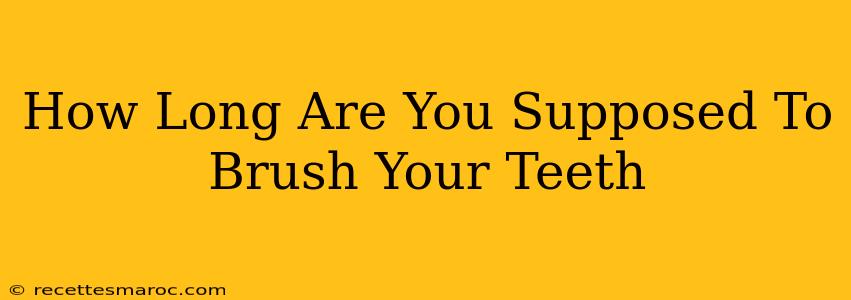Are you brushing your teeth long enough? Many people underestimate the importance of brushing duration, leading to less-than-optimal oral hygiene. This comprehensive guide will delve into the recommended brushing time, why it matters, and how to make sure you're hitting the mark.
The Gold Standard: Two Minutes, Twice a Day
The American Dental Association (ADA) recommends brushing your teeth for a full two minutes, twice a day. This isn't just a suggestion; it's the minimum time needed to effectively remove plaque and food particles from all tooth surfaces. Failing to reach this target leaves behind bacteria, increasing your risk of cavities, gum disease, and other oral health problems.
Why Two Minutes?
Two minutes allows for thorough cleaning of each tooth surface. This includes:
- Outer surfaces: The parts of your teeth you see when you smile.
- Inner surfaces: The sides of your teeth facing your tongue.
- Chewing surfaces: The tops of your teeth.
- Gumline: The area where your teeth meet your gums.
How to Time Your Brushing
It's surprisingly easy to underestimate how long you're brushing. Here are some helpful tips:
- Use a timer: Set a timer on your phone or use a toothbrush with a built-in timer. Many electric toothbrushes have timers that automatically shut off after two minutes.
- Divide and conquer: Mentally divide your mouth into quadrants (upper right, upper left, lower right, lower left). Spend about 30 seconds brushing each quadrant.
- Brush to a song: Choose a song that's approximately two minutes long and brush along to the music.
- Use a brushing chart: Visually track your progress with a brushing chart, especially helpful for children.
Consequences of Inadequate Brushing
Brushing for less than two minutes consistently can lead to:
- Increased plaque buildup: Plaque is a sticky film of bacteria that can lead to cavities and gum disease.
- Gingivitis: Inflammation of the gums, characterized by redness, swelling, and bleeding.
- Periodontal disease: A severe form of gum disease that can lead to tooth loss.
- Bad breath: Bacteria build-up contributes significantly to halitosis (bad breath).
- Cavities: Tooth decay caused by acid produced by bacteria.
Beyond Brushing Time: Other Important Factors
While brushing for two minutes is crucial, it's only part of the equation. Other important aspects of good oral hygiene include:
- Proper brushing technique: Use gentle, short back-and-forth strokes, paying attention to all tooth surfaces.
- Choosing the right toothbrush: Select a toothbrush with soft bristles and a head size appropriate for your mouth.
- Flossing daily: Flossing removes plaque and food particles from between your teeth, where your toothbrush can't reach.
- Regular dental checkups: Visit your dentist for professional cleanings and checkups at least twice a year.
Conclusion: Make Time for Healthy Teeth
Making time for proper oral hygiene is an investment in your overall health. By brushing for the recommended two minutes, twice a day, and following other good oral hygiene practices, you can significantly reduce your risk of dental problems and maintain a healthy, confident smile for years to come. Remember, consistent effort is key! So, put on your favorite two-minute song and start brushing!

